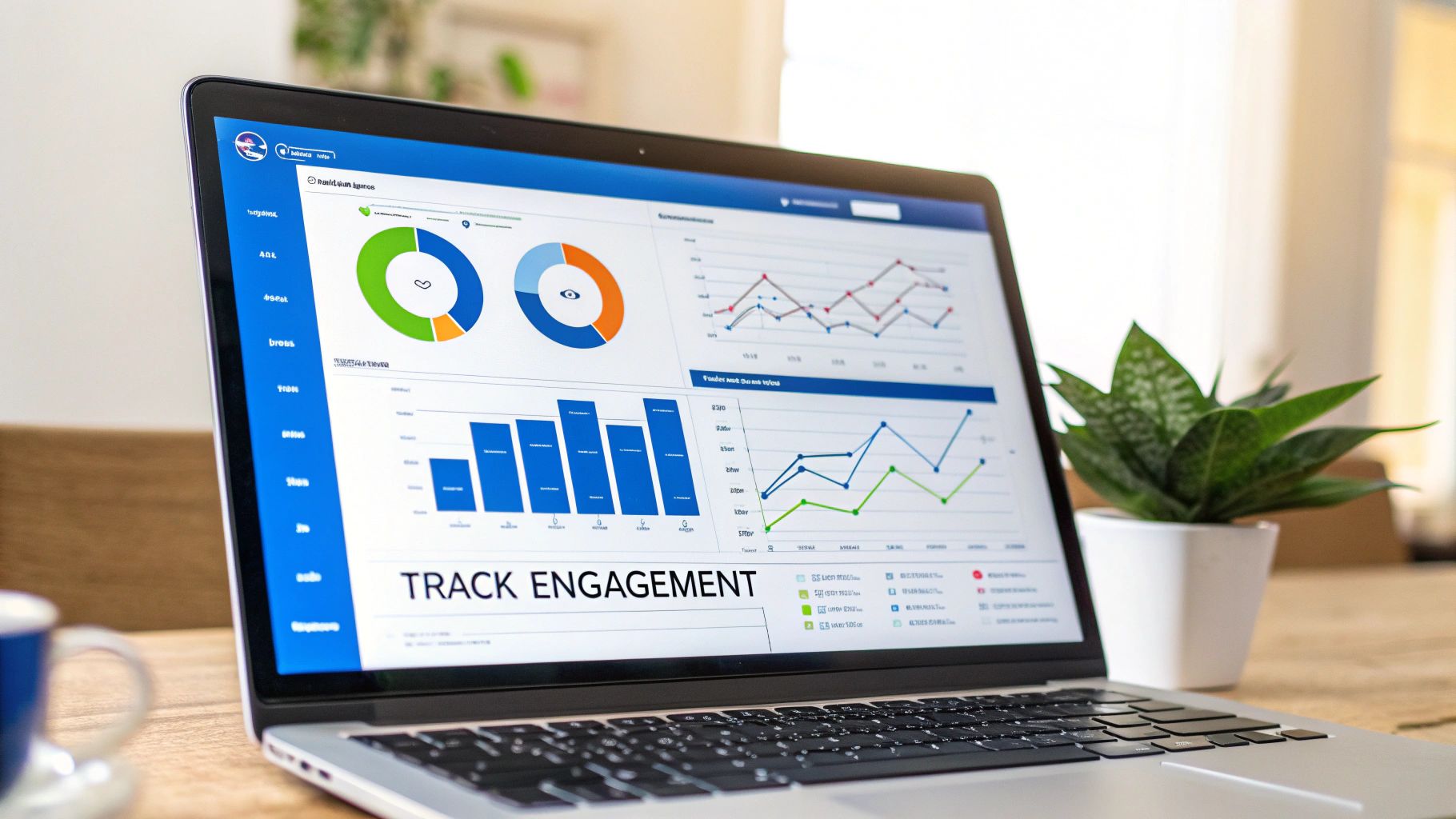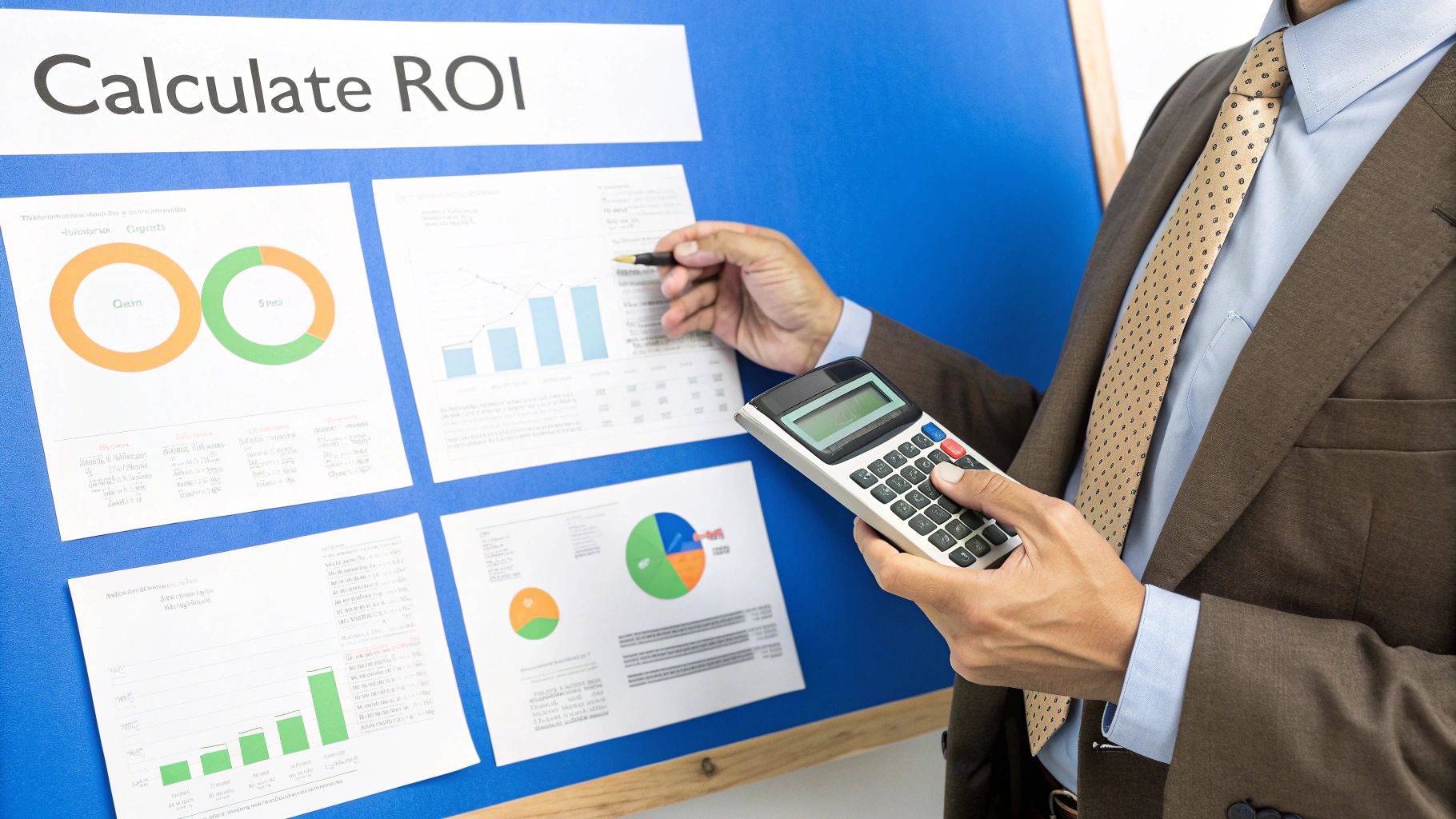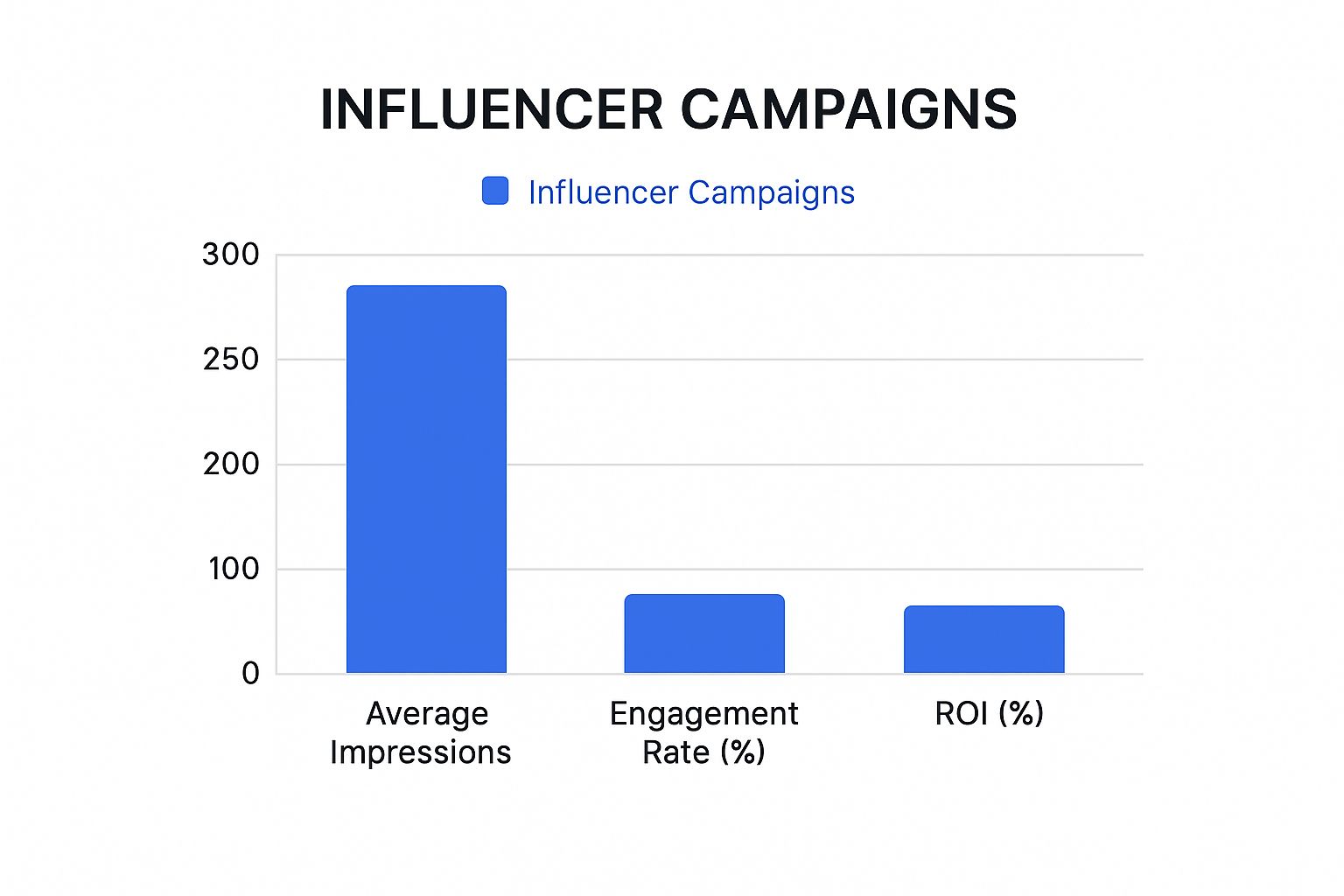For years, measuring influencer marketing meant one thing: chasing vanity metrics. We all got caught up in the obsession with likes and follower counts, but let's be honest—that approach is broken. A successful modern strategy demands a serious shift toward metrics that prove a tangible return on investment (ROI).

Relying on superficial stats like a creator's follower count or the number of likes on a post is a recipe for wasted budget and misleading results. A massive audience doesn't guarantee engagement, and a viral post doesn't automatically translate into sales. It's a hard lesson many brands have had to learn.
Think about this all-too-common scenario: A skincare brand partners with a mega-influencer who has 5 million followers. The campaign post racks up 100,000 likes, and on the surface, it looks like a home run. But when the finance team digs into the sales data, they find only a handful of conversions directly tied to the campaign. The ROI is negative, and everyone is left wondering what went wrong.
The real problem here is attribution. The customer journey is rarely a straight line from seeing a post to clicking "buy." A potential customer might see an influencer's story, search for the brand on Google later that day, get hit with a retargeting ad the next, and finally make a purchase after an email promotion.
Superficial metrics completely miss this messy, multi-touch reality. This is where a more robust approach to influencer marketing measurement becomes non-negotiable. Without it, you're just flying blind, unable to tell the difference between influencers who look popular and those who actually drive business outcomes.
You can dive deeper into how data reveals true top performers in our guide on influencer marketing analytics.
The industry is finally growing up, moving past simple vanity stats. The focus now is on connecting influencer activities directly to tangible business results like customer acquisition, revenue, and long-term brand equity.
The explosive growth of the creator economy confirms this shift. The influencer marketing industry is projected to hit a global market size of $32.55 billion in 2025—a massive leap from $1.7 billion in 2016. This isn't just speculative spending; over 80% of marketers confirm it's a highly effective strategy, and more of them are now partnering with nano-influencers who deliver authentic engagement over sheer reach.
When you stop chasing likes and start tracking what actually moves the needle, you shift from renting an audience to building a predictable, profitable growth channel. You start seeing real value.
To get a clearer picture of what to track, it helps to separate the fluff from the substance. Many marketers get stuck on vanity metrics because they're easy to see, but they don't tell the whole story. Actionable business metrics, on the other hand, connect influencer activity directly to your bottom line.
Here’s a breakdown of the two:
Metric TypeExamplesWhat It Really MeasuresBusiness LimitationVanity MetricsLikes, Follower Count, Comments, ReachSurface-level popularity and potential audience size.No direct connection to sales, revenue, or customer acquisition cost. Easily inflated and often misleading.Actionable Business MetricsConversion Rate, CAC, ROAS, AOVThe actual financial impact and efficiency of the campaign.Requires more sophisticated tracking and attribution but provides a true measure of success and profitability.
Focusing on actionable metrics provides the clarity needed to make smart, data-backed decisions. Instead of just seeing likes, you start seeing value. This is how you identify which influencers are true partners in growth and which are just noise.
Here’s what you should be laser-focused on instead:
Understanding the nuances of different content formats, like mastering influencer stories measurement, is also crucial for a comprehensive view beyond static posts. By adopting this ROI-focused mindset, you can finally prove—and improve—the real impact of your influencer marketing efforts.

Before you can even think about measuring influencer marketing ROI, you have to define what "success" actually looks like for your business. Simply saying you want to "increase awareness" is far too vague to be useful. Real, measurable progress only starts when you set specific, actionable targets that tie directly to your bottom line.
This means you need to stop using fuzzy objectives and start setting concrete goals. Instead of "boosting engagement," your goal should be something like, "achieve a 5% average engagement rate on all sponsored Instagram posts." Instead of just "driving traffic," it becomes "generate 10,000 landing page visits from influencer UTM links this quarter."
This is the kind of specificity that turns influencer marketing from a speculative expense into a predictable growth channel. It gives you a clear yardstick to measure every effort against, ensuring every dollar you spend has a clear purpose.
Your influencer marketing goals should never exist in a vacuum. They need to be a direct extension of your company's bigger picture—whether that’s increasing revenue, breaking into a new market, or building a die-hard community. The trick is to start with the desired business outcome and then work backward to create your influencer goals.
Let's break down how this works for two common business objectives.
A critical part of successful influencer marketing measurement is understanding that not every campaign needs to drive immediate sales. A well-placed campaign can build trust and awareness that pays off months down the line. The trick is setting the right goals to measure that value.
Once your goals are locked in, the next move is to map them to the correct Key Performance Indicators (KPIs). These are the specific, granular metrics you'll track to see if you're on your way to hitting those goals. This alignment ensures you’re collecting the right data from the very beginning.
Don't skip this part. Choosing the wrong KPIs will give you a completely distorted view of performance, potentially causing you to scale campaigns that are actually duds or cut ones that are quietly performing well. To get the full picture, you often need to understand how different touchpoints contribute to a single conversion. You can learn more about this by exploring how to measure marketing attribution, a concept that’s essential for accurate analysis.
Here’s a quick guide to connecting your goals directly to actionable KPIs:
For Sales-Focused Goals:
For Brand-Building Goals:
By establishing this clear framework—from broad business objectives to specific goals and down to granular KPIs—you create a powerful system for influencer marketing measurement. This data-driven foundation is what will empower you to make smarter decisions, optimize your budget, and finally prove the undeniable value of your influencer program.

Alright, you’ve got your goals and KPIs. Now it's time to build the engine that will actually collect your data. This is where theory gets real, fast.
An effective tech stack for influencer marketing measurement doesn't need to be crazy complicated, but it absolutely must be precise. This is the foundation that makes sure every click, conversion, and dollar is tied to the right person.
Without this technical backbone, even the best plans fall apart. You end up with a mess of data and more questions than answers. The goal here is to swap guesswork for a crystal-clear, real-time view of what's working.
Before you jump into sophisticated platforms, let's nail the basics. These two methods are the bedrock of manual influencer tracking. They can give you a ton of value, especially if you're just starting out or working with a tight budget.
SARAH20), and you can track every single purchase made with that code directly in your e-commerce platform, whether it's Shopify or WooCommerce. It's a straight line from their content to your revenue.These tools are great, but they do have their limits. They often struggle to show the full customer journey, especially when someone interacts with your brand multiple times. This is where specialized platforms really shine.
To get a truly accurate picture of an influencer's impact, you need a system that connects all the dots. This is where dedicated marketing attribution platforms like Cometly become absolute game-changers. They go way beyond that first or last click and show you the entire sequence of events that led to a sale.
This is more important than ever. The way we measure influencer marketing has shifted big time, with a massive focus on ROI-driven strategies. Top brands are ditching vanity metrics for numbers that actually mean something. Research shows that 73% of brands have now integrated AI tools into their influencer workflows to get accurate outcomes. It's not a fluke—66.4% of marketers say these data-focused strategies are improving their campaign results, giving them the confidence to spend more on influencers.
You can learn more about this shift to data-backed influencer strategies and see the full research from PR Newswire.
The real power of an attribution platform is its ability to serve as a single source of truth. It pulls data from your ad accounts, e-commerce store, and influencer links into one dashboard, killing off data silos and the nightmare of manual spreadsheets.
This unified view is what allows you to perform sophisticated influencer marketing measurement and make decisions you can actually stand behind.
Setting up a platform like Cometly is designed to be pretty straightforward. The whole process is about connecting your digital world so you can start tracking what matters.
For instance, a dashboard in Cometly gives you an at-a-glance view of how all your marketing sources are performing.

This screenshot shows a clear breakdown of marketing performance, attributing metrics like purchases, cost per purchase (CPP), and return on ad spend (ROAS) to specific sources. You can immediately see which channels are profitable and which are bleeding money, letting you make fast, data-driven decisions to shift your budget for better results.
Once you have a solid tracking system in place, you’re no longer guessing about performance. Now it’s time for the moment of truth: analyzing the data to figure out your actual return on investment. This is where you connect every dollar spent directly to the revenue it generated.
Calculating influencer ROI isn't rocket science, but it does demand close attention to detail. It all comes down to one simple, powerful formula.
(Revenue Attributed to Influencer - Total Influencer Cost) / Total Influencer Cost
This calculation gives you a clear ratio or percentage, showing you exactly how much you earned for every dollar invested. A result of 3 (or 300%) means you brought in $3 in revenue for every $1 you spent.
The single biggest mistake I see brands make is underestimating the "Total Influencer Cost." It’s so much more than just the fee you paid the creator. To get an accurate ROI, you have to be honest and account for every single expense tied to that campaign.
Think beyond the main invoice. Your total cost needs to include:
For example, let's say you paid an influencer a $1,000 fee, sent them $250 worth of product, and spent $50 on shipping. Your real cost for that partnership is $1,300, not just the $1,000 fee. Ignoring those extra costs will give you a dangerously inflated ROI and a false sense of success.
The infographic below shows how various metrics, including ROI, work together to paint a complete picture of campaign performance.

While metrics like impressions show reach, it’s the numbers like engagement rate and, most importantly, ROI that reveal true effectiveness and financial return.
To bring this to life, let’s walk through a real-world example. Imagine you partnered with a fitness influencer named Alex to promote your new protein powder.
Here's how the numbers might stack up in a simple table.
MetricExample ValueCalculation or NoteInfluencer Fee$2,000The flat fee paid to Alex for two Instagram posts and three stories.Product Cost$150The retail value of the protein powder and shaker bottle sent to Alex.Shipping$25The cost to ship the products.Total Influencer Cost$2,175$2,000 + $150 + $25Attributed Revenue$8,700Tracked via Alex’s unique discount code and UTM link in Cometly.
Now, we just plug these numbers into our ROI formula:
( $8,700 - $2,175 ) / $2,175 = 3.00
Your ROI is 3.0, or 300%. That’s a home run. It means for every single dollar you invested in the campaign with Alex, you generated $3 in return. This is the kind of hard, data-backed metric you can take to your leadership team to prove the value of your program.
This level of clarity is only possible with precise tracking of both costs and attributed revenue. And remember, different ways of assigning that revenue, like first-touch or multi-touch, can add even more nuance to your analysis. To get a better handle on this, you should explore the different marketing attribution models available.
While ROI is the ultimate measure of financial success, it's not the only number that matters. Leading indicators like click-through rates (CTR) and conversion rates can help you spot top-performing creators early on, sometimes even before the final revenue numbers are in.
Think about these two scenarios:
By analyzing these leading metrics, you can make smarter, data-driven decisions about who to build lasting relationships with. This is how you turn your influencer program from a series of one-off campaigns into a predictable and scalable growth engine for your brand.
Effective influencer marketing measurement isn't a one-and-done report you glance at after a campaign wraps up. It's a living, breathing process that should fuel constant improvement. All that data you worked so hard to collect is your roadmap to systematically scaling what works, cutting what doesn’t, and turning your influencer program into a predictable, profitable growth engine.
This is where you move beyond simply finding good influencers and into a phase of strategic, data-backed optimization. Every metric—from conversion rates to audience demographics—is a clue that can help you refine your approach, making each campaign smarter than the last.
Once your tracking is dialed in, you have the power to build a much more sophisticated, performance-based compensation model. Instead of just paying a flat fee for every influencer, you can create a system that directly rewards your top partners for the actual value they drive.
This approach creates a powerful win-win. Influencers are motivated to create their best, most authentic content because their earnings are directly tied to the results. At the same time, you de-risk your investment by paying for proven performance, not just potential.
Here are a few performance-based structures we've seen work incredibly well:
This data-driven approach transforms your relationships from transactional one-offs into true, strategic partnerships.
With enough data, you'll start to see clear patterns emerge among your most successful influencers. The goal here is to shift your mindset from, "I think this influencer is a good fit," to, "I know this type of influencer profile works for us."
Dive into your analytics and start looking for the common threads that link your highest-ROI partners. What’s the unifying factor?
Identifying these common characteristics gives you a data-backed "persona" for your ideal influencer. This insight is incredibly valuable, as it allows you to refine your selection process for all future campaigns, dramatically increasing your odds of success from the start.
This analytical approach is quickly becoming the industry standard. The growth in influencer partnerships is massive, with 59% of marketers planning to work with more influencers. In fact, 77% of brands already engage with up to ten creators at once to diversify their efforts. This layered strategy allows for much better influencer marketing measurement, as brands can compare performance across different creator tiers and platforms to identify what truly resonates. Find out more about how brands are calibrating their strategies by reviewing the latest industry numbers.
Optimization is a marathon, not a sprint. Even when you have a roster of high-performing influencers, there's always room to get better. A/B testing is a powerful way to fine-tune the small details of your campaigns that can add up to huge gains in ROI.
Using your attribution platform, you can systematically test different variables with your influencers to see what moves the needle. The key is to change only one variable at a time so you can clearly attribute any change in performance to that specific element.
Consider testing these variables:
This iterative process of testing and measuring takes the guesswork out of the equation. It’s also crucial for understanding how different touchpoints contribute to a final sale, a concept we explore in much more detail in our guide to multi-touch attribution. By constantly optimizing, you ensure your program not only scales but gets more efficient and profitable over time.
As you get deeper into data-driven influencer marketing, you’re going to hit some tricky questions. It’s one thing to talk about measurement in theory, but another to actually put it into practice. This is where most brands get stuck.
Let's clear up some of the most common points of confusion I see. Getting these details right is what separates a fuzzy, unpredictable influencer program from a confident growth channel.
This is a big one. Measuring the ROI of a brand awareness campaign can feel like trying to catch smoke, but it's totally doable. You just have to shift your focus from direct sales to non-financial KPIs that show your brand's footprint is growing.
Instead of looking for immediate revenue, watch these key indicators:
While you can't put a direct dollar value on it immediately, tracking these metrics proves the campaign is building valuable brand equity that pays dividends down the road. This whole process is about connecting actions to outcomes, which is the heart of marketing analytics. If you want to build a stronger foundation in this area, you can learn more about understanding the definition of marketing analytics and how these principles apply to all your efforts.
There's no magic number here. A "good" Return on Ad Spend (ROAS) completely depends on your profit margins, industry, and what you’re trying to achieve. That said, a common benchmark that many e-commerce brands shoot for is a 3:1 to 6:1 ROAS. This means for every $1 you spend, you’re bringing in $3 to $6 in revenue.
Remember, the most important benchmark is your own break-even point. A 2:1 ROAS could be a massive win for a high-margin software product but a total loss for a low-margin CPG brand.
To figure out your target, you have to do the math. Calculate your Cost of Goods Sold (COGS) and other variable costs to determine the absolute minimum ROAS you need to be profitable. Use that number as your real benchmark for success.
The measurement timeline should mirror your product's sales cycle. It's not one-size-fits-all.
For low-cost, impulse-buy items, you can often see a sales spike within 24 to 72 hours. In these cases, you can get a good read on the immediate impact pretty quickly.
But for higher-ticket items that require more thought—like furniture, high-end electronics, or an online course—the full impact might not show up for weeks, or even months. For these products, it’s critical to set a longer attribution window in your analytics tools (think 30, 60, or even 90 days) to make sure you capture those delayed conversions.
Here’s a best practice I recommend: Check early indicators like clicks and engagement at the 7-day mark to get a pulse on things. Then, run a full ROI analysis at the 30-day and 60-day marks to see the campaign's long-tail effect.
Absolutely. It just requires more elbow grease. You can build a surprisingly solid tracking system using tools that are completely free.
Here’s what you need:
MARIA15) and track how many times it’s used right inside your e-commerce platform.While platforms like Cometly automate all of this and give you much deeper insights, a manual system built on these free tools is a fantastic way to get started and prove out the channel.
Ready to stop guessing and start getting crystal-clear attribution data from every influencer? Cometly provides a single source of truth, connecting all your marketing efforts to actual revenue. Sign up for a demo today and see how you can finally prove—and improve—your true ROI.
Learn how Cometly can help you pinpoint channels driving revenue.
.svg)
Network with the top performance marketers in the industry